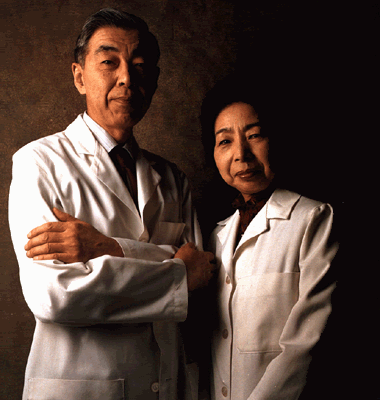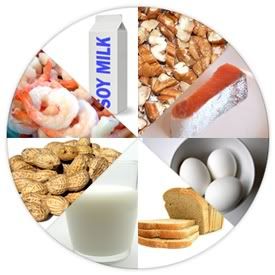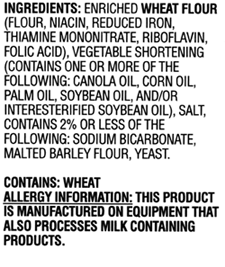I'm back yet again! Now I'm going to post a history of food allergies. This is by no means all there is on food allergies. I worked for months compiling this information for a school project (email me if you want a copy of the manual) and there's quite a bit. So if you're a history buff, you'll enjoy this. If you hate history, don't read it. I'll start with the past and then talk about the present and future (I'll include links to my sources right after, if it's a book I'll put a B, pictures you can click on). If you have food allergies, it's good to know what's been done and what's being done to help us out.
First of all, what are food allergies?
According to the Center for Disease Control and Prevention (CDC), a food allergy is an abnormal immune response to certain foods that the body reacts to as harmful (1). With food allergies, it is a reaction to the protein in a food. The eight most common food allergies are cow’s milk, eggs, soybeans, peanuts, tree nuts, fish, shellfish, and wheat. The first time you eat it, you won’t have an allergic reaction, but your body will adapt. The protein in the allergenic food you consume is an antigen. When the food meets your cells, something called an antibody is produced. They then attach to cells and form a compound to fight off harmful substances. Then, the next time you eat a food containing that antigen, it meets up with the antibody, causing your body to produce a reaction. No one knows why this occurs but many studies are being performed.About 12 million Americans suffer from these allergies and the number is dramatically rising (2). The most common cases are seen in children.
In the beginning:
In the beginning:
The first believed mention of a food allergy was in Lucretius’s 55 BC poem De Rerum Natura when he stated, “What is food for some, may be fierce poison for others” and continued on with Hippocrates mentioning how some people produce pain from milk (B1).
Galen, a physician in the second century, recorded cases of curious reactions to drugs, which was most likely an allergy (B2).
Robert Willan, the founder of dermatology, recorded a serious reaction upon the consumption of almonds in 1808 (B1).
Just eleven years later, Dr. John Bastock defined hay fever (3), which was then proven to be an immune system response in 1906 (B1).

Also in that year Drs. Clemens Von Pirquet and Bela Schick first used the word “allergy,” derived from “allos ergos,” the Greek phrase meaning altered reactivity (B1).
 In 1919, the first allergy shots were used to provide desensitization of allergens (B1), and about twenty years later the first antihistamine drugs were produced (3).
In 1919, the first allergy shots were used to provide desensitization of allergens (B1), and about twenty years later the first antihistamine drugs were produced (3).

Also in that year Drs. Clemens Von Pirquet and Bela Schick first used the word “allergy,” derived from “allos ergos,” the Greek phrase meaning altered reactivity (B1).
 In 1919, the first allergy shots were used to provide desensitization of allergens (B1), and about twenty years later the first antihistamine drugs were produced (3).
In 1919, the first allergy shots were used to provide desensitization of allergens (B1), and about twenty years later the first antihistamine drugs were produced (3). Finally, in 1967, Kimishige and Teruko Ishizaka discovered Immunoglobulin E (IgE), the antibody responsible for many allergic reactions (3).
Present Day:
Present Day:
Due to the increasing cases of food allergies, the Food and Drug Administration (FDA) has put in place many acts and regulations to support the food allergy community. The first major step was The Fair Packaging and Labeling Act of 1967 that required food packaging to label the contained ingredients (4). Only until recently was there an act passed to help out food allergy sufferers. In 2006, the Food Allergen Labeling and Consumer Protection Act took effect; this requires that if a product contains any of the top eight allergens, it must be labeled as so (5). As mentioned before, these allergens are milk, eggs, soybeans, fish, tree nuts, peanuts, wheat, and shellfish. These must be listed in two ways: either directly after the ingredient in parentheses (Ex: whey (milk)) or after the entire ingredients list (Contains: Milk). For fish, shellfish, and tree nuts, the product must label which direct source or type it comes from (5). While the food industry is progressing moderately, the restaurant industry isn’t as much. Nothing has been passed mandating ingredient listing or even allergen listing. This is largely due to chefs having their recipes duplicated, which is understandable. Some restaurant chains have progressed independently in that they are providing an allergy menu, or a menu that states what allergens the foods have. While this is a huge advancement it is still tough for diners with food allergies to eat out, due to lack of allergy free foods and server knowledge. Massachusetts is attempting to eradicate this ignorance. Bill 2701 went into effect in Massachusetts just three months ago (6). This bill mandates that every menu must tell customers to alert their waiter if they have a food allergy. Restaurant employees will be instructed on food allergies and how to prevent cross-contamination. The Department of Public Health has to implement a process to categorize certain restaurants as food allergy friendly that will be placed on their website. For a restaurant to be classified that way, however, they have to provide a list of their ingredients for each item to the public. These are just a few of the many benefits to the bill.Food allergy is a relatively new concept so there is much more progress that can be made. Currently, The National Institute of Allergy and Infectious Diseases is making advancements on how and why people respond they way they do to certain foods (7). The organization is testing several theories on ways to build up tolerances to allergens. More and more research organizations are springing up due to the increased cure, treatment demand, and allergy case rising.
All in all, the food and restaurant industries are slowly adapting to consumers with food allergies. We have come a long way since the first allergy experimentation in the nineteenth century. Many restaurants are following suit on providing allergy menus. Companies producing allergy friendly foods are springing forth, including an abundance of cookbooks. Restaurants and companies are satisfying allergic customers and are progressing daily, no matter how slowly.
-Michelle














0 comments:
Post a Comment